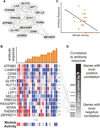Systems biological approaches to measure and understand vaccine immunity in humans
- PMID: 23796714
- PMCID: PMC3797847
- DOI: 10.1016/j.smim.2013.05.003
Systems biological approaches to measure and understand vaccine immunity in humans
Abstract
Recent studies have demonstrated the utility of using systems approaches to identify molecular signatures that can be used to predict vaccine immunity in humans. Such approaches are now being used extensively in vaccinology, and are beginning to yield novel insights about the molecular networks driving vaccine immunity. In this review, we present a broad review of the methodologies involved in these studies, and discuss the promise and challenges involved in this emerging field of "systems vaccinology."
Keywords: Systems biology; Systems vaccinology; Vaccines.
Copyright © 2013 Elsevier Ltd. All rights reserved.
Figures


References
-
- Plotkin S, Plotkin S. The development of vaccines: how the past led to the future. Nature reviews Microbiology. 2011;9:889. - PubMed
-
- Germain RN. Vaccines and the future of human immunology. Immunity. 2010;33:441–450. - PubMed
-
- Rappuoli R, Aderem A. A 2020 vision for vaccines against HIV, tuberculosis and malaria. Nature. 2011;473:463–469. - PubMed
-
- Pulendran B, Ahmed R. Translating innate immunity into immunological memory: implications for vaccine development. Cell. 2006;124:849–863. - PubMed
Publication types
MeSH terms
Substances
Grants and funding
LinkOut - more resources
Full Text Sources
Other Literature Sources
Medical

